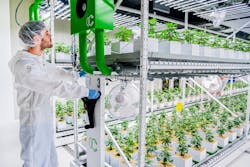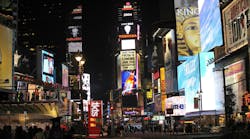Fluence by Osram has revealed details of a medicinal cannabis growing operation located near the Switzerland capital city of Bern that is using vertical farming techniques. The grower named Cannerald said the very expensive real estate in the heart of the Swiss region made a vertical layered approach lit with solid-state lighting (SSL) a natural choice for maximizing the output of its facility. Moreover, Cannerald is using 100% LED-based lighting for all phases of the operation including mother stock, cloning, vegetation, and flowering.
We’ve written repeatedly about vertical farming but mostly related to leafy greens and herbs. Such operations either use horizontal layers or racks that stack many layers and have low-profile LED fixtures dedicated to each layer or that grow plants in vertical columns. We first started to cover such vertical techniques around 2014 when pioneer Green Sense Farms arrived on the scene. More recently, growers such as venture-backed Plenty plant in vertical column structures where nutrients flow ceiling to floor.
Vertical farms, however, have not been seen as a good match for cultivars that grow tall. For instance, some tomato and cucumber growers have plants that reach heights of 15 ft or more. And cannabis growers have also generally allowed plants to grow tall.
The indoor cannabis community is evolving quickly, however, with medicinal and recreational legalization bringing research to the community. At our HortiCann Light + Tech Conference in 2019, we had a presentation by Black Dog LED that revealed growing research showing benefits of shorter plants. And the business case also comes into play. At the HortiCann 2020 event, we had a presentation from the Sacramento Municipal Utility District that revealed the business benefits of a vertical orientation.
That same space utilization goal drove Cannerald in its facility design process. “Growing vertically was essential when designing our facility,” said Levin Amweg, co-founder of Cannerald. “We found with the size limitations of our building, our multi-layer approach allowed us to fit more plants into less space to ensure we fully leveraged every cubic meter throughout our facility.”
The layered system utilizes Fluence’s SPYDR Series of LED fixtures for the vegetative stage. LED-based fixtures radiate far less heat than do legacy sources, and the Fluence fixtures can be located as close as 6 in. from the plant canopy. The Cannerald facility is using one of Fluence’s broad-spectrum light recipes. We covered some of that technology in a recent story on research. For Cannerald, the spectra delivers the energy that the plants need and also quality lighting for the workers tending the crop.
“There are a lot of different LED grow light spectra on the market today,” said Severin Amweg, Cannerald’s co-founder and head grower. “When we tested different LED and spectral offerings, broad-white spectra on SPYDR outperformed the rest. It also allows us to accurately account for plant health since our eyes are already accustomed to white light.”
The grower uses Fluence’s VYPR series of luminaires for care of its mother stock. Fluence’s RAZR fixtures are used for propagation.
The SSL installation overseen by Cannerald has also allowed the company to meet the requirements of GMP (Good Manufacturing Processes). GMP is a European Commission program that primarily guides manufacturing and import in the pharmaceutical sector. GMP compliance has begun to be applied in the cannabis sectors both in Europe and Canada. Cannerald said that the GMP practices ensure that its plants consistently deliver critical secondary metabolites and overall high quality.
LEDs Magazine chief editor MAURY WRIGHT is an electronics engineer turned technology journalist, who has focused specifically on the LED & Lighting industry for the past decade.
For up-to-the-minute LED and SSL updates, why not follow us on Twitter? You’ll find curated content and commentary, as well as information on industry events, webcasts, and surveys on our LinkedIn Company Page and our Facebook page.





